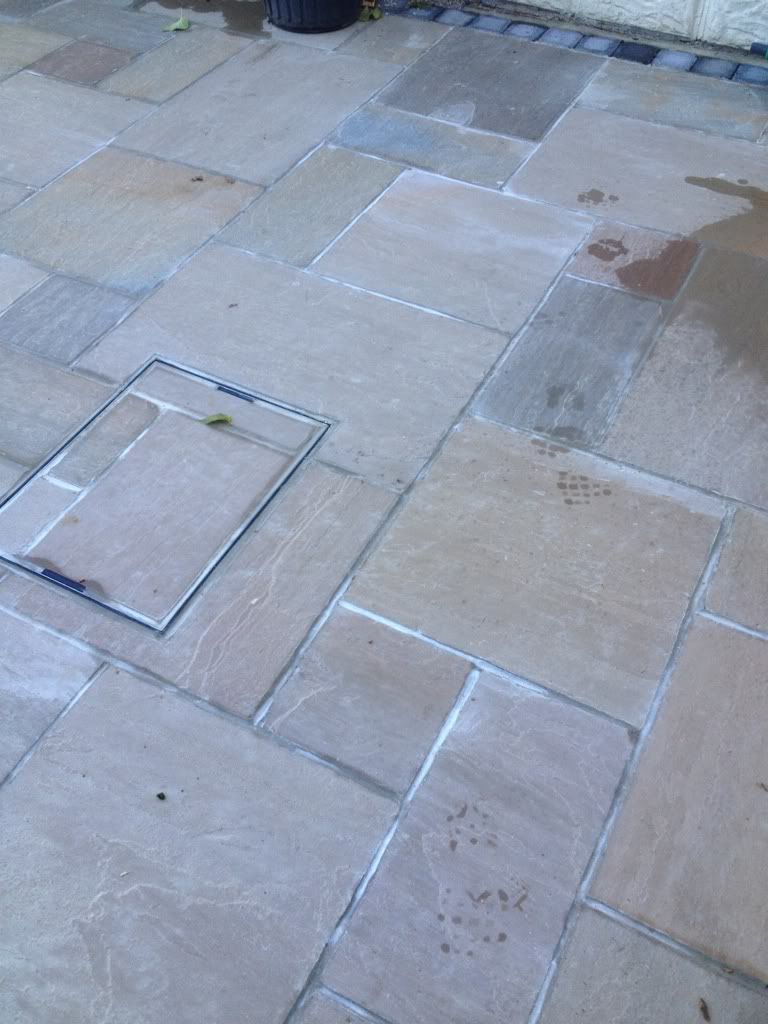Page 1 of 1
Posted: Sun Nov 11, 2012 9:58 pm
by Thepinkpavingco
Had phone call a few days after I finished a sandstone patio the lady said to me that the pointing had gone white. I thought this funny as I'd used a black mortar dye (powder form). The mix I used was not my usual 3:1 plastering sand and cement on this instance I'd used building sand 3:1 with a small cup of dye i gun injected it all in and on the day there was a light shower I ironed it all up and covered it with polythene. The next day I did my usual of scrap any snots off and gave it hose down and stiff brush.


I've suggested ill give it a jet wash and maybe two coats of sealer but I really want to make it right for the ppl nice old couple any suggestions appreciated. My work doesn't usually come out like this HONEST
Posted: Sun Nov 11, 2012 10:22 pm
by Pablo
Ah balls that's disappointing mate personally I'd give it a light acid wash and clean with a washer and leave it till the spring sealant etc will likely make it worse just now. If it's not lifted by the spring then look at your options.
Posted: Sun Nov 11, 2012 10:27 pm
by Thepinkpavingco
Thanks Pablo don't think they will wear it till the spring though.
Posted: Mon Nov 12, 2012 12:23 am
by lutonlagerlout
looks like a bit of efflorescence to me
its a combination of high cement content,damp weather and covering it over has caused it
we had some awful problems after a shower on that last patio we did ,and we used acid on some affected areas
there are still odd bit that need doing but the client has agreed to wait till spring when we go back to do another 30m
what made you use soft sand?
when i have tried soft sand in the gun it never flows?
i strongly feel that a bit of weather will see that off and would be reluctant to touch it at all
cheers LLL
Posted: Mon Nov 12, 2012 6:56 am
by cookiewales
try the non acid cleaner geo apply with small brush just to pointing should do the job its the plastic made it sweat nice job ps dont use building sand unless in small quants :;):
Posted: Mon Nov 12, 2012 9:50 pm
by Brucieboy
It's definitely efflorescence (aka lime bloom). Reasons for it all as stated above, i.e. light rain, polythene sheeting etc. I've experienced exactly the same on a few jobs with black bricklaying mortar (particularly when used with the non-absorbant class A blue engineering bricks). Some architects have insisted the brickwork be knocked down not appreciating that efflorescence is a phenomenon thats very difficult to control and eliminate. We've always fought our case and won.
As stated above, a very carefully-applied light acid wash will probably remove it but overdo it and you'll dissolve too much cement at the surface which, in turn, will remove some of the pigment resulting in a lighter, more sandy colour.
Personally, as per LLL, I'd leave it to weather over the winter but there's still a high probability it will still be there in the spring. Review the course of action then.
Posted: Mon Nov 12, 2012 11:22 pm
by Thepinkpavingco
cheers for the advice fellas but i feel ive got to try something they really aint happy 
Posted: Tue Nov 13, 2012 12:05 am
by lutonlagerlout
I would say they are being picky, rake out and repoint is the only sure fire cure
LLL
Posted: Tue Nov 13, 2012 9:04 am
by Tony McC
Even with a rake-and repoint, there's a risk the same thing will happen again. Whenever you combine cement-rich materials with damp weather and low temps, you are almost inviting eff to occur.
Pink: I'd point them to the FAQ on this site as a source of independent information and tell them that it's a transient effect which is widely known about in the trade and not considered to be structurally relevant. If they want to challenge you on aesthetic grounds, there's not a court in the kingdom that would support them.
Posted: Wed Nov 14, 2012 10:31 pm
by Thepinkpavingco
Thanks everyone going Sunday with my magic sponge



